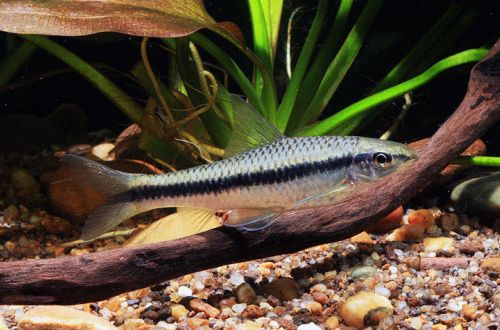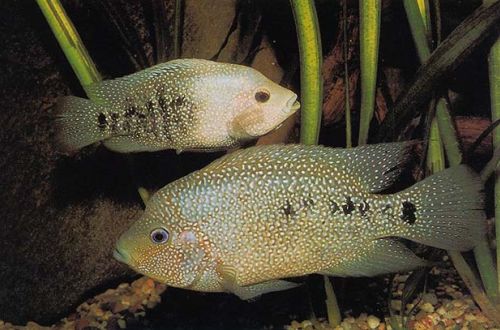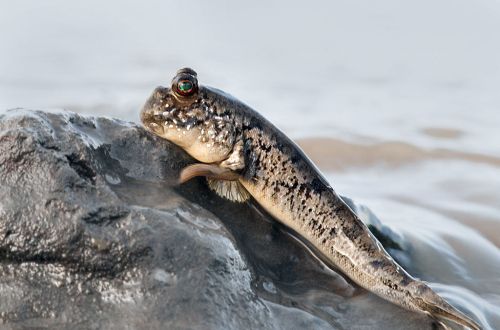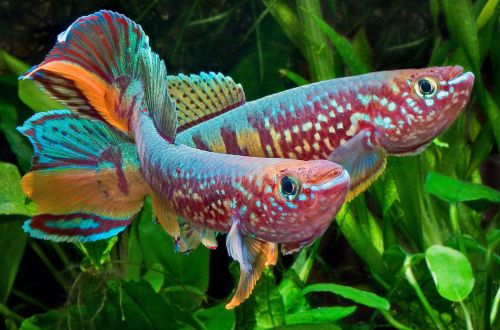
Siamese algae eater
The Siamese algae eater, scientific name Crossocheilus oblongus, belongs to the Cyprinidae family. Due to its gastronomic features, it is considered one of the best algae eaters. However, its closest relatives are often on sale, who are not averse to eating decorative aquarium plants. If you plan to purchase this species solely for algae control, then chances are high that you made the wrong choice.

Contents
Habitat
They originate from Southeast Asia from the territory of modern Vietnam, Laos, Cambodia and Thailand. It lives throughout the entire basin of the Mekong and Chao Phraya rivers. It lives in small rivers and streams with a fast current among boulders and flooded snags. During the spawning season, they migrate to deeper and murkier waters. The rest of the time, the fish prefer to stay in well-lit areas in shallow water, where algae actively grow, covering the bottom with a continuous veil.
Brief information:
- The volume of the aquarium – from 100 liters.
- Temperature – 20-26°C
- Value pH — 6.0–7.5
- Water hardness – soft or medium hard (1-15 dGH)
- Substrate type – any
- Lighting – bright
- Brackish water – no
- Water movement – moderate
- The size of the fish is about 7 cm.
- Nutrition – only plant foods
- Temperament – peaceful
- Content in a group of at least 6–8 individuals
Description
Adult individuals reach a length of about 7–7.5 cm. Sexual dimorphism is weakly expressed, females are only slightly larger than males. It is unlikely that it will be possible to reliably determine the sex of a particular fish, especially in a group of different ages. The coloration is silvery with a dark horizontal stripe stretching from head to tail. Fins and tail are translucent.
Outwardly, the fish resembles Epalceorhynchus, which is why it is often confused with it. In addition, there are several closely related species with almost identical coloration and body pattern.
Food
In nature, they feed on algae and other phytoplankton. Plant foods such as flakes or granules of spirulina or similar products should be fed into the aquarium. Pieces of zucchini, spinach, cucumber, apples, blanched peas will be a good addition to the diet. As an additional source of food, algae growing on the walls or design elements of the aquarium can serve.
There are several closely related species supplied under the same name. Some of them also eat plant leaves in addition to algae and can cause serious damage to your underwater garden.
Maintenance and care, arrangement of the aquarium
The optimal size of an aquarium for a flock of 6 fish starts from 100 liters. It belongs to unpretentious species, can adapt to various conditions. However, the most comfortable conditions are achieved in an environment that resembles a natural habitat. In the design, it is desirable to provide for moderate water movement, simulating the flow of rivers, heaps of boulders, sandy or fine gravel substrate, a few snags and dense clusters of plants. Bright lighting will promote the growth of algae, the presence of which in this case is welcome.
Like any other fish that comes from regions with running water, the Siamese algae eater does not tolerate excessive accumulation of organic waste. Regular maintenance (changing part of the water, cleaning the soil with a siphon) and installing a productive filtration system are mandatory. The latter can also become a source of current in the aquarium.
Behavior and Compatibility
Peaceful calm fish, gets along well with other non-aggressive species of comparable size. Intraspecific relationships are built on a hierarchy between strong and weak individuals. The content in the group is at least 6–8 fish. With a smaller number, a weaker individual may be attacked by relatives.
Breeding / breeding
In the wild, spawning is accompanied by long migrations, which is accompanied by changes in water hydrochemistry. It is very problematic to recreate such features of the external environment in aquariums. Therefore, at the time of this writing, no successful cases of breeding the Siamese algae eater at home have been recorded in open sources. In commercial fish farms, fish are bred with hormones.
Fish diseases
The main cause of most diseases is unsuitable living conditions and poor-quality food. If the first symptoms are detected, the water parameters and the presence of high concentrations of hazardous substances (ammonia, nitrites, nitrates, etc.) should be checked first. If necessary, bring the indicators back to normal and only then proceed with treatment. Read more about symptoms and treatments in the Aquarium Fish Diseases section.





